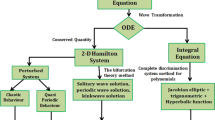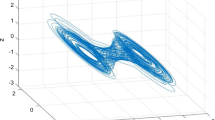Abstract
Discrete-time linear periodic single-input/single-output (SISO) systems having uniform relative degree are considered. A closed-form expression of the blocking input is derived and exploited to obtain a computationally advantageous characterization of the structural zeros. Indeed, it suffices to compute the eigenvalues of a suitably defined (n × n) matrix, wheren is the system order. It is shown that, in contrast to the general case studied in previous papers, the number of zeros of linear periodic SISO systems with uniform relative degree is always time invariant and equal to the difference between the system order and the relative degree. The new characterization is also used to provide a simple expression for the zeros of linear periodic systems described by input-output difference equations.
Similar content being viewed by others
References
S. Bittanti, Deterministic and stochastic linear periodic systems, inTime Series and Linear Systems, S. Bittanti, ed., Springer-Verlag, Berlin and New York, 1986, pp. 141–182.
S. Bittanti and P. Bolzern, Discrete time linear periodic systems: Gramian and modal criteria for reachability and controllability,International J. Control 41, 909–928, 1985.
S. Bittanti and P. Bolzern, On the structure theory of discrete-time linear systems,Int. J. Systems Science 17, 33–47, 1986.
S. Bittanti, P. Bolzern, and P. Colaneri, The extended periodic Lyapunov lemma,Automatica 5, 603–605, 1985.
S. Bittanti, P. Bolzern, and G. Guardabassi, Some critical issues on the state-representation of time-varying ARMA models,IFAC Symp. Identification and System Parameter Estimation, York, U.K., 1479–1483, 1985.
S. Bittanti, P. Colaneri, and G. De Nicolao, The difference periodic Riccatti equation for the periodic prediction problem,IEEE Trans. on Automatic Control AC-33, 706–712, 1988.
P. Bolzern, P. Colaneri, and R. Scattolini, Zeros of discrete-time linear periodic systems,IEEE Trans. on Automatic Control AC-31, 1057–1058, 1986.
P. Colaneri, R. Scattolini, and N. Schiavoni, LQG optimal control of multirate sampled-data systems,IEEE Trans. on Automatic Control AC-37, 675–682, 1992.
G. Conte, A. M. Perdon, and S. Longhi, Zero structure at infinity of linear periodic systems,J. Circuits Systems Signal Process.10, 91–100, 1991.
W. A. Gardner, ed., Special issue on cyclostationary signals,IEEE Signal Processing Magazine 8, 2, 1991.
W. A. Gardner, ed.,Cyclostationarity in Communications and Signal Processing, IEEE Press, New York, 1994.
O. M. Grasselli, A canonical decomposition of linear periodic discrete-time systems,International J. Control 40, 201–214, 1984.
O. M. Grasselli and F. Lampariello, Dead-beat control of linear periodic discrete-time systems,International J. Control 33, 1091–1106, 1981.
O. M. Grasselli and S. Longhi, Disturbance localization with dead-beat control for linear periodic discrete-time systems.International J. Control 44, 1319–1347, 1986.
O. M. Grasselli and S. Longhi, Zeros and poles of linear periodic multivariable discrete-time systems,J. Circuits Systems Signal Process. 7, 361–380, 1988.
R. E. Kalman, Canonical structure of linear dynamical systems,Proc. Nat. Acad. Sci. U.S.A. 48, 569–600, 1962.
D. Malah and B. A. Shenoi, Reduction and transformation of linear discrete-time-varying systems,International J. Control 16, 1127–1136, 1972.
A. G. Miamee, On recent developments in prediction theory for cyclostationary processes, inCyclostationarity in Communications and Signal Processing, IEEE Press, New York, 480–493, 1994.
S. Pinzoni, Stabilization and control of linear time-varying systems, Ph.D. thesis, Arizona State University, Tempe, AZ, 1989.
R. G. Shenoy, D. Burnside, and T. W. Parks, Linear periodic systems and multirate filter design,IEEE Trans. on Signal Processing SP-42, no. 9, 2242–2255, 1994.
W. Y. Yan, B. D. O. Anderson, and R. R. Bitmead, On the gain margin improvement using dynamic compensation based on generalized sampled-data hold functions,IEEE Trans. on Automatic Control AC-39, 2347–2354, 1994.
C. Yang and P. T. Kabamba, Multi-channel output gain margin improvement using generalized sampled-data hold functions,IEEE Trans. on Automatic Control AC-39, 661–675, 1994.
K. S. Yeung and Y. J. Huang, On the determination of zeros of a SISO system,IEEE Trans. on Automatic Control AC-34, 475–476, 1989.
Author information
Authors and Affiliations
Additional information
This paper has been partially supported by MURST Project Model Identification, System Control, Signal Processing.
Rights and permissions
About this article
Cite this article
De Nicolao, G., Trecate, G.F. On the zeros of discrete-time linear periodic systems. Circuits Systems and Signal Process 16, 703–718 (1997). https://doi.org/10.1007/BF01371573
Received:
Revised:
Issue Date:
DOI: https://doi.org/10.1007/BF01371573




